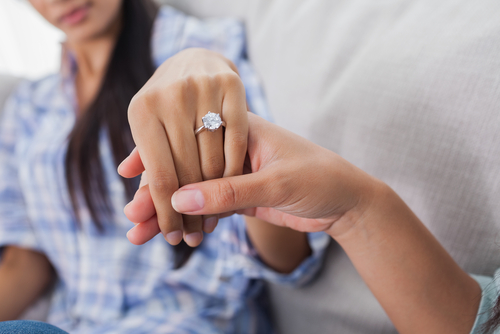If you want to make someone happy with a special ring, it helps to know something about them and what they are looking for. Of course, you know a lot of that already, and that is why you decided to look for something special for your sweetheart. That is also why you are getting engaged.
There are many things to consider when it comes to getting an engagement ring. The most successful start with finding that person’s desires, and then maybe putting a bit of your own spin on it. There are always subtle questions to ask. What is her favorite stone? Is she certain she would want a diamond? What shape should that diamond be?
There are not just diamonds out there. Other color stones are often cut in similar fashions. Sapphires, rubies, and emeralds are also often used as center or side stones for engagement rings. A traditional approach is to surround a color stone with a halo of diamonds, both enhancing the stone’s hue and adding plenty of sparkle.
Many, however, are looking for the traditional diamond, and there are still lots of choices to make within that stone alone. There are, of course, the classic four “C’s”, Color, Cut, Clarity, and Carat.
Color has the most variation, and is often given a letter grade. D is the purest white stone and usually the most valuable. Grades then go down to the popular E, F, & G. At H and I they start to look a little yellow or brown, especially against a white surface or when compared to a higher graded diamond. Down around the grade of M, the stones start to become more expensive, as they are often called Fancy Yellow or Chocolate diamonds. You can also find green, blue, and pink diamonds, though if natural they are often extremely valuable.
Cut is usually intended to mean shape. Round, princess, and marquis are some of the most well known, but it can also refer to the quality of that cut. This characteristic is one of the most important to making the diamond sparkle. If a talented cutter used the correct angles, the light refraction is greatly increased. The polish and proportion of a stone are very key to this, and it is something that really is only best seen in person.
Clarity is a determination of flaws, or inclusions, in the stone, and it is rated from Internally Flawless to Included. There are several levels of each from IF, to VVS1&2, VS1&2, S1&2, and I1-3. These are often subjective calls, and usually need to be graded by a professional. With a good gut and color, many VS2 and S1 stones can make absolutely gorgeous engagement rings.
That leaves Carat, which is a measure of size. Don’t get too lost in that. Size is important, but it is not always what makes the most beautiful stone. And as it is ultimately a measure of weight, so a stone of different proportions, may look larger than one that is actually smaller.

